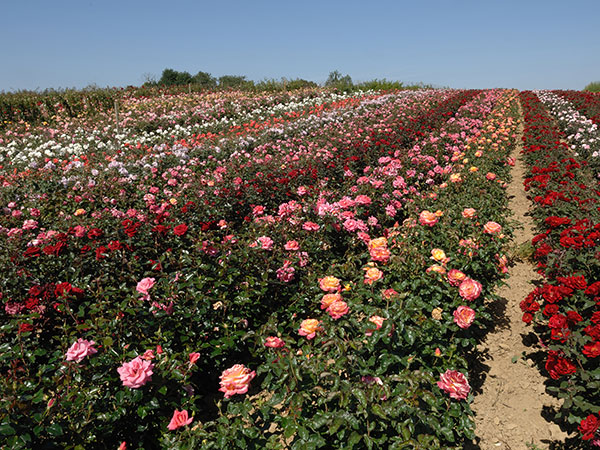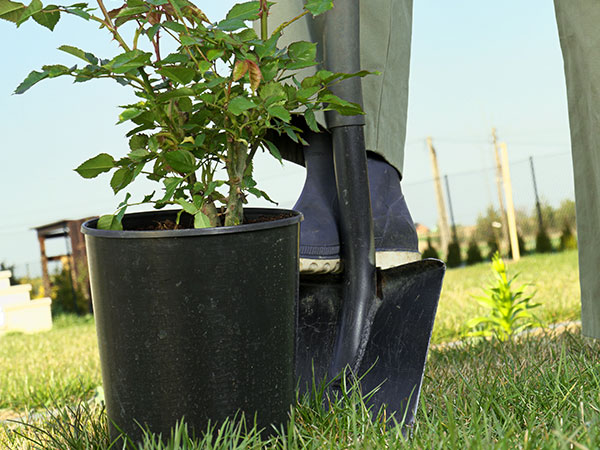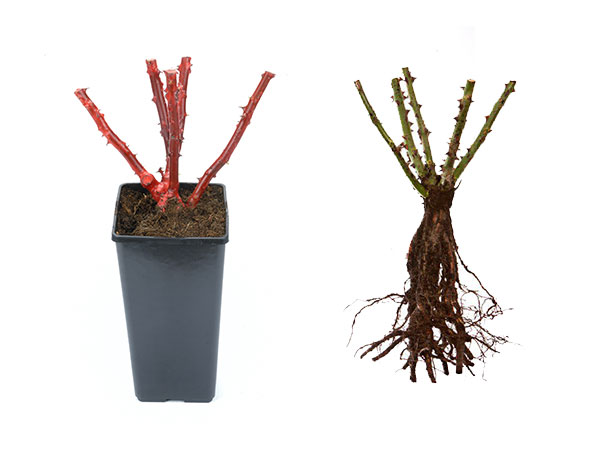General Tips
When tackling roses bear the following in mind;
- Cuts should be no more than 5mm (¼ in) above a bud and should slope away from it, so that water does not collect on the bud. This applies to all cuts, whether removing dead wood, deadheading or annual pruning.
- Cut to an outward-facing bud to encourage an open-centred shape. With roses of spreading habit, prune some stems to inward-facing buds to encourage more upright growth.
- Cut to the appropriate height, if a dormant bud is not visible.
- Cuts must be clean, so keep your secateurs sharp. For larger stems, use loppers or a pruning saw.
- Prune dieback to healthy white pith.
- Cut out dead and diseased stems and spindly and crossing stems.
- Aim for well-spaced stems that allow free air flow.
- On established roses, cut out poorly flowering old wood and saw away old stubs that have failed to produce new shoots.
- With the exception of climbing roses and shrub roses, prune all newly planted roses hard to encourage vigorous shoots.
- Trace suckers back to the roots from which they grow and pull them away.
These tips should be read in conjunction with the appropriate rose pruning profile.
When you first receive our roses they will arrive already hand pruned when appropriate, so all you will need to do at the start is plant and watch them grow and come into flower, New growth on Climbing and Rambling Roses will need supporting, training and tying in to trellis or wires and this information will be provided with the rose in our free Planting & After Care Guide.
Summer Dead Heading
After the rose flower has finished blooming and the petals start to fall away, the remaining flower head, if pollinated, will then start to form a round hip and seeds, the forming of hips on the modern roses we supply is something you don’t want to encourage as leaving them on the rose then sends a message back to the rose that its job is done for the year and there is no need for it to flower anymore that year and all the plant’s efforts will then be put into producing hips and seed.
Cut these dead flowers off as soon as possible after flowering and the rose will then re-invigorate itself and re-shoot and re-flower, repeat this through summer and autumn and you will get up to 3 or 4 heavy flushes of flower from June until hard frosts on many of the varieties we supply and depending on the length and temperature of the summer.
Deadheading is easy, simply hold the old finished flower and prune off 2 or 3 leaves or 6 to 9 inches down to just above a leaf, the more leaves you leave the quicker the rose will re-flower as it will have more immediate energy; for roses with large heavy single flower heads and trusses make sure the stem you leave is at least the thickness of a pencil at the point of cutting, this will make the new shoot strong enough to support the flower head of the next rose flower, helping to stop blooms from drooping. Put all your waste cuttings onto the bonfire or bin rather than discarding on the ground around your roses, this will help to keep them disease free.
Winter Pruning
This is an important job for roses, nearly all gardening books and so called TV Garden Experts tell you to do your main pruning in March, trouble is, this advice goes back to old books and information from a 100 years ago when winters were generally much harder, longer and colder and the Rose rootstocks used for propagating the roses onto were much less hardy than the modern Rosa Laxa Rootstock used today by most UK growers.
Most UK roses in March have long new shoots on them by this point, cutting them off in March will simply delay flowering and lose you at least one flush of summer rose flowers.
There are a very small number of exceptions that require little or no pruning other than general shaping or removing dead wood. These are Canary Bird, Rosa moyesii geranium and Rosa glauca.
For all other roses we recommend pruning when conditions seem favourable (ie: when the snowdrops are flowering and the birds begin singing). In March for all areas, re-check the roses you have pruned for any further winter stem die-back, and if any is seen simply cut this off below the brown stem to healthy wood just above a leaf.
Main Points of Winter Pruning
When you are hard winter pruning your roses these are points to consider and remember:
- Pruning any rose hard, is usually very beneficial and very unlikely to kill it.
- Pruning a rose back hard encourages completely new shoots from the base of the plant which will become main flowering branches in subsequent years.
- If, at the point of cutting, the core of the wood in the centre of the stem is white, the rose is alive at this point, if the core is brown at the point of cutting the stem is dead and you need to cut the stem back further until you get to a white core, sometimes this can take you back down to the very base of the plant.
- Where possible cutting back to thicker stems, minimum pencil thickness will promote new shoots strong enough to support the flowers and trusses in later months
- Although not essential, cutting the stems at a slight angle will help stop water sitting on the cut stems and help to prevent die-back problems.
- Cutting dead, thin, weak and old stems out of the middle of the bush or standard head, creating an open airy structure will help prevent disease problems through the season.
- Dispose of your rose pruning and cuttings in the bin or on a bonfire, don’t leave them laying around under your pruned roses long term or put them on the compost heap as this will also encourage disease problems in the future.
Remember to also feed your roses twice a year in spring and mid-summer with a granular rose feed such as Empathy After Plant Rose Food ( roses in containers 3 times a year) with a Granular Rose Feed which should also contain trace elements including Iron, Manganese and Boron. We also recommend ‘Toprose’.
We recommend you winter prune the following different types of roses in the following way
Repeat Flowering Climbing Roses
These will need support using wires or trellis, Initially, try to train the branches horizontally to create a framework which helps keep leaves and blooms lower down in later years, tie in new growth with soft string. After 2-3 years the rose should reach the desired height and once reached after flowering, prune off to your desired height. In following years flowering side shoots will emerge from the main branches you’ve left and these should be pruned back to 2″ from the main stems every year during the winter. In later years, cut back at least one of the main stems to about 6 – 12″ from the ground, this will encourage brand new basal shoots which you should then re-train as main flowering branches.
Patio Climbing Roses/Repeat Flowering Ramblers
These can be grown on an obelisk, on short pillars, arches and narrow trellis. Simply tie in growth as it goes up, no hard pruning required other than pruning to desired shape, summer dead-heading of large numbers of tiny dead flowers and hips can be done more easily by lightly trimming the whole plant using hedge shears.
Traditional Rambling Roses
Just plant and let go, some initial support and tying in may be needed, Rambling roses can be left for many years without pruning but if the rose does get too big, cut back after flowering in summer as many ramblers flower on the previous years new growth, otherwise leave the hips for a colourful autumn display.
English and Shrub Roses
Cut back all growth to around 60cm or 2ft in the winter.
Hybrid Tea & Floribunda Roses
Cut back all growth to around 30cm or 1ft in the winter.
Patio Roses
Cut back all growth to around 15cm or 6″ in the winter.
Standard Roses
H.T and Floribunda: Prune top growth back to approx 25cm from main stem. Patio 15cm. Weeping standards should only be lightly pruned to desired shape but always check for and remove any dead or diseased wood in the centre of the head.
Re-check your roses regularly for stem die-back and prune out any dead or diseased brown stems and wood immediately, allowing die-back to reach the very base of the rose plant or the main stem of a standard rose could well kill the rose completely or lead to the complete loss of the graft.


